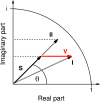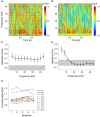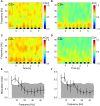Selective Increase of Auditory Cortico-Striatal Coherence during Auditory-Cued Go/NoGo Discrimination Learning
- PMID: 26793085
- PMCID: PMC4707278
- DOI: 10.3389/fnbeh.2015.00368
Selective Increase of Auditory Cortico-Striatal Coherence during Auditory-Cued Go/NoGo Discrimination Learning
Abstract
Goal directed behavior and associated learning processes are tightly linked to neuronal activity in the ventral striatum. Mechanisms that integrate task relevant sensory information into striatal processing during decision making and learning are implicitly assumed in current reinforcement models, yet they are still weakly understood. To identify the functional activation of cortico-striatal subpopulations of connections during auditory discrimination learning, we trained Mongolian gerbils in a two-way active avoidance task in a shuttlebox to discriminate between falling and rising frequency modulated tones with identical spectral properties. We assessed functional coupling by analyzing the field-field coherence between the auditory cortex and the ventral striatum of animals performing the task. During the course of training, we observed a selective increase of functional coupling during Go-stimulus presentations. These results suggest that the auditory cortex functionally interacts with the ventral striatum during auditory learning and that the strengthening of these functional connections is selectively goal-directed.
Keywords: Mongolian gerbil; auditory cortex; avoidance learning; discrimination learning; field-field coherence; functional coupling; shuttlebox; ventral striatum.
Figures








Similar articles
-
Selective Interruption of Auditory Interhemispheric Cross Talk Impairs Discrimination Learning of Frequency-Modulated Tone Direction But Not Gap Detection and Discrimination.J Neurosci. 2022 Mar 9;42(10):2025-2038. doi: 10.1523/JNEUROSCI.0216-21.2022. Epub 2022 Jan 21. J Neurosci. 2022. PMID: 35064004 Free PMC article.
-
Right auditory cortex lesion in Mongolian gerbils impairs discrimination of rising and falling frequency-modulated tones.Neurosci Lett. 1998 Aug 14;252(2):115-8. doi: 10.1016/s0304-3940(98)00561-8. Neurosci Lett. 1998. PMID: 9756335
-
Bilateral ablation of auditory cortex in Mongolian gerbil affects discrimination of frequency modulated tones but not of pure tones.Learn Mem. 1999 Jul-Aug;6(4):347-62. Learn Mem. 1999. PMID: 10509706 Free PMC article.
-
Behavioral semantics of learning and crossmodal processing in auditory cortex: the semantic processor concept.Hear Res. 2011 Jan;271(1-2):3-15. doi: 10.1016/j.heares.2010.10.006. Epub 2010 Oct 29. Hear Res. 2011. PMID: 20971178 Review.
-
Involvement of basal ganglia and orbitofrontal cortex in goal-directed behavior.Prog Brain Res. 2000;126:193-215. doi: 10.1016/S0079-6123(00)26015-9. Prog Brain Res. 2000. PMID: 11105648 Review.
Cited by
-
State Transitions During Discrimination Learning in the Gerbil Auditory Cortex Analyzed by Network Causality Metrics.Front Syst Neurosci. 2021 Apr 22;15:641684. doi: 10.3389/fnsys.2021.641684. eCollection 2021. Front Syst Neurosci. 2021. PMID: 33967706 Free PMC article.
-
β-adrenergic modulation of discrimination learning and memory in the auditory cortex.Eur J Neurosci. 2019 Oct;50(7):3141-3163. doi: 10.1111/ejn.14480. Epub 2019 Jul 1. Eur J Neurosci. 2019. PMID: 31162753 Free PMC article.
-
Dynamic θ Frequency Coordination within and between the Prefrontal Cortex-Hippocampus Circuit during Learning of a Spatial Avoidance Task.eNeuro. 2022 Apr 21;9(2):ENEURO.0414-21.2022. doi: 10.1523/ENEURO.0414-21.2022. Print 2022 Mar-Apr. eNeuro. 2022. PMID: 35396256 Free PMC article.
-
Proteome rearrangements after auditory learning: high-resolution profiling of synapse-enriched protein fractions from mouse brain.J Neurochem. 2016 Jul;138(1):124-38. doi: 10.1111/jnc.13636. Epub 2016 May 26. J Neurochem. 2016. PMID: 27062398 Free PMC article.
-
Differential Contributions of Nucleus Accumbens Subregions to Cue-Guided Risk/Reward Decision Making and Implementation of Conditional Rules.J Neurosci. 2018 Feb 21;38(8):1901-1914. doi: 10.1523/JNEUROSCI.3191-17.2018. Epub 2018 Jan 18. J Neurosci. 2018. PMID: 29348192 Free PMC article.
References
-
- Barth D. S., Di S. (1990). Three-dimensional analysis of auditory-evoked potentials in rat neocortex. J. Neurophysiol. 64, 1527–1536. - PubMed
LinkOut - more resources
Full Text Sources
Other Literature Sources

